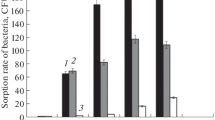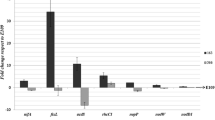Abstract
Medicago laciniata, an annual leguminous plant of Saharo-Sindian origin, is particularly refractory to root nodulation by most strains ofRhizobium meliloti. Using a series of such bacterial strains belonging to the 8 groups of Brockwell and Hely, and a variety of environmental conditions, it was noted that several normally non-nodulating strains (at 20°C) produced ineffective nodules at root temperatures of 24°C to 28°C. Nodulation at 20°C failed to occur in the presence of a wide variety of test compounds and physical conditions. No phytoalexins or anti-Rhizobium growth inhibitors were isolated from inoculated root tissue at any temperature. Temperature shift experiments indicated no infection of the root hairs at 20°C, and infection threads produced at the permissive root temperature failed to elongate after transfer to 20°C. However, if meristematic activity had been initiated in the inner root-cortical cells as a result of infection thread penetration at 28°C, no blockage of nodule maturation occurred upon subsequent transfer to 20°C root temperature. Nodules produced at 28°C were completely devoid of nitrogenase activity, although the apical (but not the distal) regions contained normal-appearing bacteriods, surrounded by enclosing membranes, and possessed a fully functional leghaemoglobin. A shortage of metabolic energy did not appear to be involved in the ineffective response. A hypothesis to explain the nodulation phenomenon observed was based on the observation in the roots of 2 factors present at 20°C but not at 28°C.
Similar content being viewed by others
References
Appleby, C. A. 1969 Electron transport systems inRhizobium japonicum. II. Rhizobium haemoglobin, cytochromes and oxidases in free-living (cultured) cells. Biochem. Biophys. Acta172, 88–105.
Appleby, C. A. 1969 Properties of leghaemoglobinin vivo, and its isolation as ferrous oxyleghaemoglobin. Biochem. Biophys. Acta188, 222–229.
Bray, H. G. and Thorpe, W. V. 1954 Analysis of phenolic compounds of interest in metabolism.In Methods of Biochemical Analysis. Vol. 1 Ed. D. Glick. Interscience Publishers, New York, pp 37–52.
Brockwell, J. A. and Hely, F. W. 1961 Symbiotic characteristics ofRhizobium meliloti from the brown acid soils of the Macquarie region of New South Wales. Aust. J. Agric. Res.8, 630–643.
Brockwell, J. A. and Hely, F. W. 1966 Symbiotic characteristics ofRhizobium meliloti: an appraisal of the systematic treatment of nodulation and nitrogen fixation interactions between hosts and rhizobia of diverse orgins. Aust.J. Agric. Res.17, 885–899.
Feder, N. and O'Brien, T. P. 1968 Plant microtechnique: some principles and new methods. Am. J. Bot.55, 123–142.
Gibson, A. H. 1963 Physical environment and symbiotic nitrogen fixation. I. The effect of root temperature on recently nodulatedTrifolium subterraneum L. plants. Aust. J. Biol.16, 28–42.
Gibson, A. H. 1965 Physical environment and symbiotic nitrogen fixation. II. Root temperature effects on the relative nitrogen assimilation rate. Aust. J. Biol. Sci.18, 295–310.
Gibson, A. H. 1967 Physical environment and symbiotic nitrogen fixation. IV. Factors affecting the early stages of nodulation. Aust. J. Biol. Sci.20, 1087–1104.
Jordan, D. C. 1974 Ineffectiveness in theRhizobium-leguminous plant association. Proc.Indian Nat. Sci. Acad., Part B40, 713–740.
Katekar, G. F. and Geissler, A. E. 1977 Auxin transport inhibitors. III. Chemical requirements of a class of auxin transport inhibitors. Plant Physiol.60, 826–829.
MacKenzie, C. R. and Jordan, D. C. 1974 Ultrastructure of root nodules formed by ineffective strains ofRhizobium meliloti. Can. J. Microbiol.20, 755–758.
Meyer, D. R. and Anderson, A. J. 1959 Temperature and symbiotic nitrogen fixation. Nature London183, 61.
Pankhurst, C. E. and Jones, W. T. 1979 Effectiveness of Lotus root nodules. II. Relationship between root nodule effectiveness andin vitro sensitivity of fast-growing lotus rhizobia to flavolans. J. Exp. Bot.30, 1095–1107.
Pankhurst, C. E. and Schwinghamer, E. A. 1974 Adenine requirement for nodulation of pea by an auxotrophic mutant ofRhizobium leguminosarum. Arch. Mikrobiol.100, 219–238.
Pankhurst, C. E., Schwinghamer, E. A., Thorne, S. W. and Bergersen, F. J. 1974 The flavin content of clovers relative to symbiosis with a riboflavin-requiring mutant ofRhizobium trifolii. Plant Physiol.53, 198–205.
Pate, J. S. 1962 Nodulation of legumes. V. The effects of temperature on symbiotic performances of bacteria associations ofMedicago tribuloides Desr. andVicia atropurpurea Desf. Phyton18, 65–74.
Phillips, D. A. 1971 A cotyledonary inhibitor of root nodulation inPisum sativum. Physiol. Plant.25, 482–487.
Phillips, D. A. 1971 Abscisic acid inhibition of root nodule initiatiion inPisum sativum. Planta Berlin100, 181–190.
Purchase, H. F., Vincent, J. M. and Ward, L. M. 1951 The field distribution of strains of nodule bacteria from species ofMedicago. Aust. J. Agric. Res.2, 261–272.
Roughley, R. J. and Dart, P. J. 1970 Root temperature and root-hair infection ofTrifolium subterraneum L. cv. Cranmore. Plant and Soil32, 518–520.
Roughley, R. J., Dart, P. J., Nutman, P. S. and Rodriguez-Barrueco, C. 1970 The influence of root temperature on root-hair infection ofTrifolium subterraneum L. byRhizobium trifolii Dang.In Proc. XI Intern. Grasslands Conference, Queensland, Australia. Plant Nutrition and Soil Fertility Section. Ed. M. J. T. Norman, Univ. Queensland Press, 451–455.
Schwinghamer, E. A. 1970 Requirement for riboflavin for effective symbiosis in clover by an auxotrophic mutant strain ofRhizobium trifolii. Aust. J. Biol. Sci.23, 1187–1196.
Stonier, T., Hudek, J., Vande-Stouwe, R. and Yang, H.-M. 1970 Studies on auxin protectors. VIII. Evidence that auxin protectors act as cellular poisers. Physiol. Plant23, 775–783.
Swaraj, K. and Garg, O. P. 1970 The effect of gibberellic acid, when applied to the rooting medium, on nodulation and nitrogen fixation in gram (Cicer arietinum). Physiol. Plant.23, 747–754.
Swaraj, K. and Garg, O. P. 1970 The effect of ascorbic acid, when applied to the rooting medium, on nodulation and nitrogen fixation in gram (Cicer arietinum). Physiol. Plant.23, 889–897.
Verma, D. P. S. and Zogbi, V. 1978 A cooperative action of plant andRhizobium to dissolve the host cell wall during development of root nodule symbiosis. Plant Sci. Lett.13, 137–142.
Vincent, J. M. 1954 The root-nodule bacteria of pasture legumes. Proc. Linn. Soc. N. S. W.79, 4–32.
Vincent, J. M. 1962 Australian studies of the root-nodule bacteria. A review. Proc. Linn. Soc. N.S.W.87, (Part 1) 8–38.
Author information
Authors and Affiliations
Rights and permissions
About this article
Cite this article
Jordan, D.C. Reduction of the nodulation barrier inMedicago laciniata by alteration of the root temperature. Plant Soil 61, 93–111 (1981). https://doi.org/10.1007/BF02277367
Received:
Issue Date:
DOI: https://doi.org/10.1007/BF02277367




